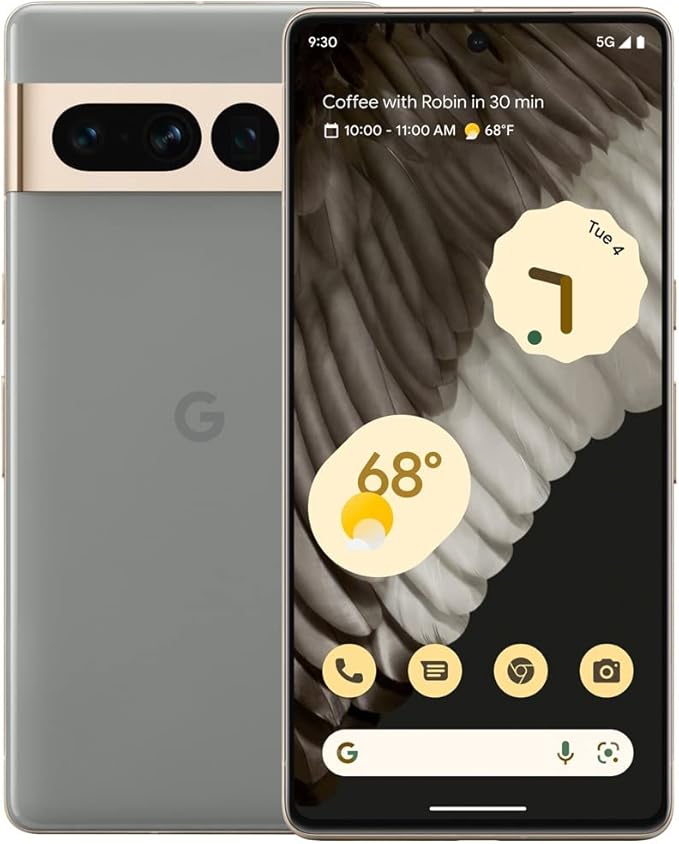In the ever-evolving world of smartphones, two giants stand at the forefront: Apple and Google. With Apple's iPhones dominating the market for years and Google's Android-based smartphones gaining significant ground, the competition between these tech titans is fierce. Both offer unique features, design aesthetics, and ecosystems that cater to different consumer preferences. Let's delve into a comparative analysis of Apple's iPhones and Google's smartphones to unravel their strengths, weaknesses, and the ongoing battle for smartphone supremacy.
Key Features Comparison
Product Selection
Apple and Google smartphones both offer a variety of product selections to cater to different users' needs and preferences. Apple's product line primarily consists of its flagship iPhone series, which includes the latest iPhone 13, iPhone 13 mini, iPhone 13 Pro, and iPhone 13 Pro Max. These models offer varying screen sizes, color options, and storage capacities, allowing users to select a device that best suits their needs. Apple's iPhones are known for their high-quality build, sleek design, and seamless integration with other Apple products, making them a popular choice among consumers. However, they are often criticized for their high price point and lack of customization options compared to other brands. On the other hand, Google's smartphone product line is more limited but still diverse. It includes the Google Pixel series, with the latest being the Pixel 6 and Pixel 6 Pro. These models are praised for their exceptional camera quality, clean Android interface, and innovative AI features. Google smartphones are also known for their regular and timely software updates, ensuring that the devices always have the latest security patches and features. However, compared to Apple, Google's smartphones may not offer as many color or storage options. While Google smartphones are generally more affordable than Apple's, they may not have the same level of prestige or brand recognition.
Availability
Apple smartphones, specifically the iPhone series, are known for their global availability. Apple has a vast network of retail stores across the world, and their products are also available in most electronic retailers. Furthermore, Apple's online store provides an additional platform for purchasing their smartphones, with shipping available to numerous countries worldwide. The latest models such as the iPhone 13 Pro and iPhone 13 mini are widely available shortly after their launch. However, availability may be hampered during the initial days of launch due to high demand, and certain specific models and colors may be harder to find. On the other hand, Google smartphones, particularly the Pixel series, have a more limited availability. While they are available for purchase on Google's online store and some electronic retailers, they do not have the same extensive physical retail presence as Apple. This is especially true in emerging markets where Google's presence is significantly less. The latest models like the Pixel 6 and Pixel 6 Pro, though launched globally, may not be immediately available in all regions. However, Google smartphones often have less demand compared to Apple, which can make acquiring them easier after the initial launch rush.
Design/Look
Apple smartphones, particularly the latest models such as the iPhone 12 and iPhone 12 Pro, are renowned for their sleek and minimalistic design. They feature a ceramic shield front cover, aerospace-grade aluminum or stainless steel edges, and a glass back, giving them a premium and sophisticated look. The iPhone 12 series also reintroduced the flat-edged design, which was a significant shift from the rounded edges of previous models. However, some users have reported that this design can make the phone feel less comfortable to hold. The notch at the top of the screen, which houses the front camera and Face ID technology, is another distinctive feature of Apple smartphones, although it has been criticized for interrupting the full-screen experience. On the other hand, Google smartphones, especially the Google Pixel 5, have a more understated design. The Pixel 5 features a 100% recycled aluminum body, which makes it more durable and less prone to damage than glass-backed phones. It also has a smaller hole-punch front camera, which is less intrusive than Apple's notch. However, the Pixel 5's design has been criticized for being too simplistic and lacking the premium feel of other flagship smartphones. Its rear-mounted fingerprint sensor, while practical, also feels somewhat dated compared to the under-display sensors or facial recognition technology used by other brands.
Affordability
When it comes to the price aspect of smartphones, both Apple and Google offer a range of options, but they cater to different segments of the market. Apple smartphones, specifically the latest iPhone 13 series, are considered premium and high-end. They are priced from $699 for the iPhone 13 Mini to $1,099 for the iPhone 13 Pro Max. The high price is justified by the advanced technologies incorporated, such as the A15 Bionic chip, Pro camera system, and ProMotion technology with 120Hz refresh rate. However, the higher price tag may not be appealing to budget-conscious consumers. On the other hand, Google smartphones, particularly the Pixel series, offer a more affordable range. The latest Google Pixel 6 starts at $599 and the Pixel 6 Pro starts at $899. These phones are equipped with Google's custom-built Tensor SoC, advanced camera software, and guaranteed software updates. While they might not match up to the iPhone in terms of premium feel and high-end specifications, Google smartphones provide excellent value for money and are a great choice for those looking for a balance between price and performance. Compared to other brands, both Apple and Google offer competitive pricing strategies, with Apple targeting the luxury segment and Google focusing on the mid-range market.
Quality/Durability
When it comes to the quality and durability of smartphones, both Apple and Google have their unique strengths. Apple smartphones, particularly the iPhone 12 series, are known for their robust build quality. The latest models are designed with Ceramic Shield, a material that Apple claims is tougher than any smartphone glass, offering four times better drop performance. Moreover, the iPhone 12 Pro models come with a surgical-grade stainless steel frame that adds to the durability. However, Apple smartphones are not entirely immune to damages, and the repair costs can be quite high, which is a downside. On the other hand, Google smartphones, specifically the Pixel series, are also well-regarded for their quality and durability. The Pixel 5, for instance, has an aluminum body that is covered in a bio-resin, making it a robust and eco-friendly choice. It also comes with Gorilla Glass 6 for screen protection, which is known for its high resistance to damage. However, Google smartphones may not match the build quality of Apple's premium models, and there have been some reported issues with the durability of older Pixel models. In terms of repairability, Google smartphones are generally considered easier and less expensive to fix than Apple smartphones. Both brands offer a different experience and it would largely depend on the user's preference and usage.
Reputation
Apple and Google are two of the most reputable brands in the smartphone industry. Apple, known for its iPhone series, has built a strong reputation for its premium design, high-quality performance, and robust security features. The company's consistent focus on innovation, as seen in the latest iPhone 12 Pro's 5G capabilities and A14 Bionic chip, has helped it maintain its standing as a leading smartphone brand. However, Apple's reputation has been somewhat tarnished by issues such as the infamous "Batterygate" scandal and criticisms over its high pricing. On the other hand, Google, with its Pixel series, has carved out a reputation for providing smartphones with exceptional camera capabilities and a clean, bloatware-free Android experience. The latest Google Pixel 5 showcases the company's commitment to these strengths, featuring a dual-camera system that excels in low-light photography and the latest Android 11 OS. However, Google's reputation has been impacted by hardware issues in past models and the perception that its phones lack the premium feel of competitors. While both brands have their strengths and weaknesses, they continue to be respected in the industry for their unique offerings and commitment to innovation.
Customer Support & Warranty
When it comes to customer support, both Apple and Google have their strengths and weaknesses. Apple's customer support is renowned for its efficiency and effectiveness. They offer multiple channels of support, including phone, chat, email, and in-person assistance at Apple stores. Their support website is also comprehensive, offering solutions to a wide range of issues. Furthermore, Apple's support also extends to their extensive ecosystem, meaning that if you have issues that involve multiple Apple devices, their support can handle it. However, Apple's customer support is often criticized for its strict adherence to warranty conditions and sometimes, the cost associated with out-of-warranty repairs. On the other hand, Google's customer support for their smartphones, while not as well established as Apple's, has been improving. Google offers 24/7 customer support for its Pixel phones, which can be accessed through phone, chat, or email. They also have a support website with a range of help articles. However, Google lacks physical stores, which means you can't get in-person support like you can with Apple. Additionally, while Google's support is generally helpful, they sometimes fall short in dealing with more complex issues, especially those involving other devices or software. Comparatively, both brands are striving to provide the best support, but Apple's extensive ecosystem and physical presence give it an edge, while Google's round-the-clock support and improvements to their support system make it a strong competitor.
Related Videos
Conclusion
In the ever-evolving world of smartphones, Apple and Google continue to push the boundaries of technology, each offering unique strengths that cater to different user preferences. Apple's iPhones are synonymous with premium design, seamless ecosystem integration, and consistent performance, making them a favorite among those who value a polished and unified user experience. Google's Pixel phones, with their pure Android experience, exceptional camera capabilities, and emphasis on software innovation, appeal to users who seek flexibility and cutting-edge AI features. Ultimately, the choice between an iPhone and a Pixel phone boils down to personal preference and priorities. Whether you are drawn to the elegance and integration of Apple’s ecosystem or the customization and AI prowess of Google’s offerings, both brands deliver top-tier smartphones that continue to set benchmarks in the industry.




















